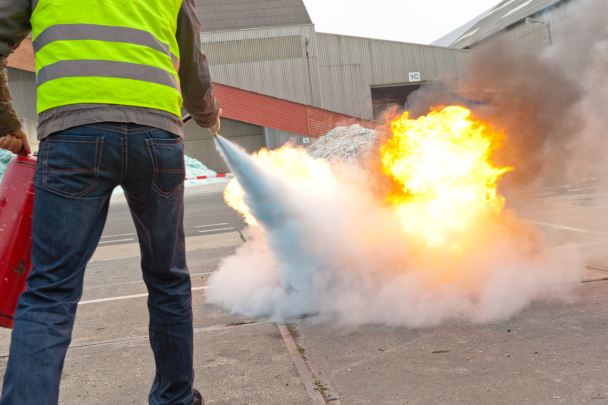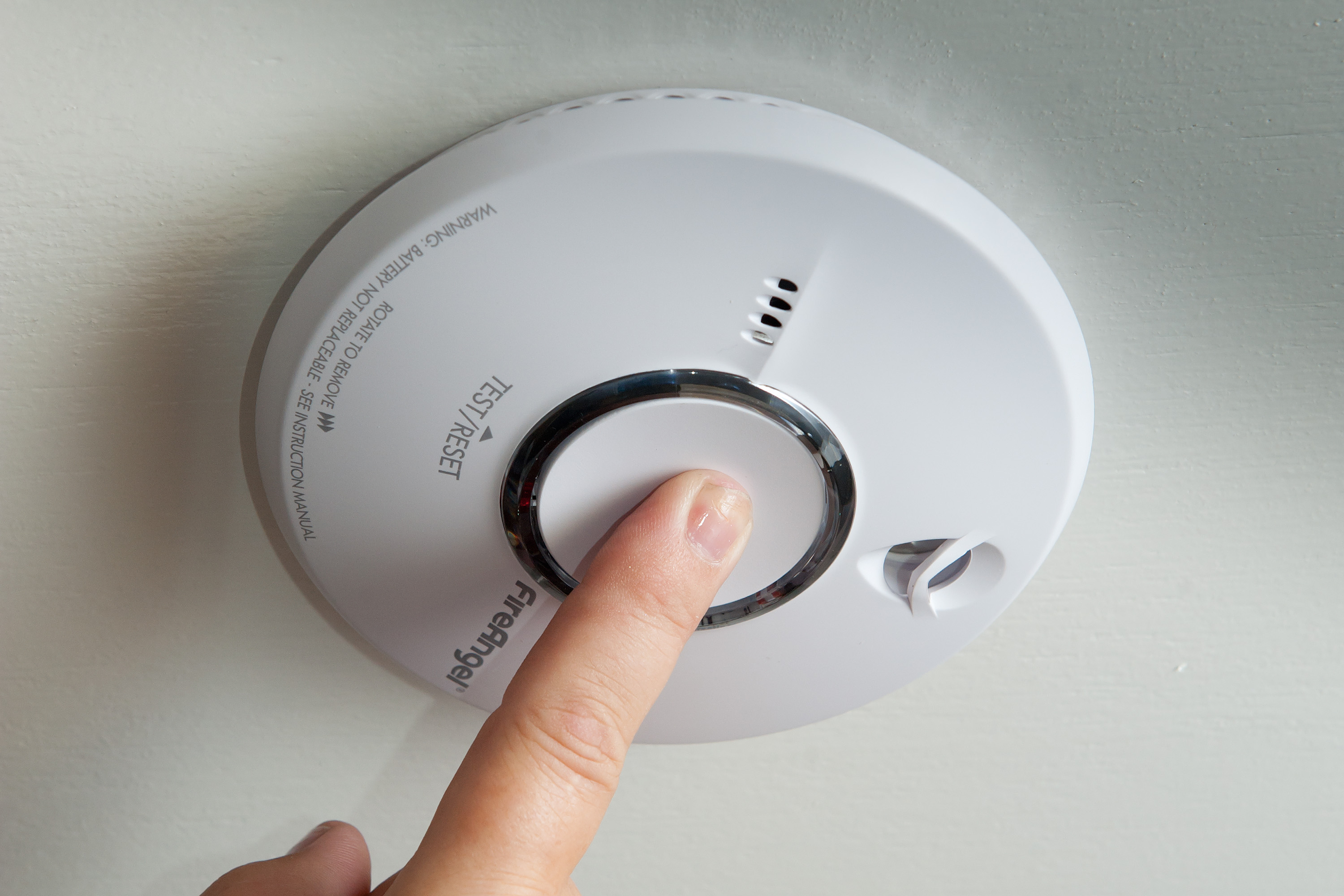Fire Extinguishers
As a business owner, you have a responsibility for the provision of appropriate firefighting equipment. It is also your responsibility to check that all firefighting equipment is located correctly and in effective working order.

Fire Extinguisher types and their uses
Here's a breakdown of the different fire extinguishers you might come across. Use the correct extinguisher for the materials that mighe catch alight in the area. Always ensure you follow the manufacturers instructions on how to use them safely.

Fire Extinguisher Regulations UK – a simple guide to fire safety
Fire extinguisher legislation in the UK can feel a little complicated.
Below we provide a simplified guide to the UK’s current laws on fire extinguishers.
As with all fire safety legislation in England and Wales, UK Fire Extinguisher regulations form part of ‘The Regulatory Reform (Fire Safety) Order 2005’, also known as the FSO.
All premises used for non-domestic purposes, with a few minor exceptions, come under this order.
Whilst the legislation has been responsible for dramatically reducing commercial fires in the UK, it can be difficult to interpret if you’re not a fire safety professional – which is why we have answered some of the most frequently asked questions below as clearly and simply as possible.
|
What is the minimum number of extinguishers I legally have to have? |
UK fire extinguisher standards recommend that you should have a minimum of two ‘Class A’ extinguishers on every storey of the building. Class A fire extinguishers are those which put out wood or paper fires, also known as ‘carbonaceous' fires. Class A fire extinguishers meeting this regulation are:
So you need at least two of any of the above on each floor. Exceptions to the rule: if your premises are very small and it would be a hindrance to escape having two extinguishers, then only one may be needed. An example would be a newspaper kiosk. |
|
Are there other types of extinguisher I have to have? |
Depending on the equipment in your business premises, you are likely to need other types of fire extinguisher. The most common of these are Carbon Dioxide (CO2) extinguishers which are used to fight electrical fires. UK fire extinguisher regulations specify:
There are very few exceptions where you won’t need a CO2 extinguisher which is why it is very common to see these paired with foam or water extinguishers, thereby meeting UK fire extinguisher legal requirements. |
|
Where should extinguishers be located? |
The ‘standard pair’ water-based and CO2 fire extinguishers are usually located by exits and fire alarm call-points. Exceptions to the rule: if your building has a lot more exits or fire alarm call-points than the number of extinguishers you need, then the 30 metre rule below dictates where they should go. The 30 metre rule comes from current UK British Standards (BS5306) and states that you should be no more than 30 metres from the appropriate extinguisher on any given level of your premises. ‘Specialist’ extinguishers, such as wet chemical and powder extinguishers should be positioned within easy reach of the specific fire hazard – e.g. the deep fat fryer. |
|
How should extinguishers be ‘fitted’? |
To comply with fire extinguisher regulations, extinguishers should be either fixed to the wall, or attached to a stand. This is to discourage people from moving them around, for example, using them to prop doors open. All extinguishers should also be clearly signposted with fire extinguisher ID signs fixed to the stand or the wall. Extinguisher ID signs explain which type of extinguisher they are, and how and when to use them. |
|
Can I buy extinguishers online without going through a fire protection company? |
You can, of course, buy fire extinguishers yourself online. Just be sure that they are the right type and size for your premises and that you know where to locate them. Fire extinguishers must be commissioned on-site by a competent person. This generally means someone who has passed the BAFE fire extinguisher exam or has an equivalent qualification. Unfortunately fire extinguishers cannot be commissioned before they are installed. This is because issues may arise during the installation itself. For this reason, you will usually still need to contact a fire protection company to commission your fire extinguishers, even though you sourced them online. |
|
What is fire extinguisher commissioning? |
‘Commissioning’ means that your fire extinguishers have been thoroughly checked and approved as good for use. Fire extinguishers are not compliant with UK fire extinguisher legislation until they have been commissioned, even if you have the right types and sizes of extinguisher in the right locations. Examples of things checked during commissioning are:
The extinguisher engineer will provide you with a certificate as evidence that your extinguishers have been commissioned in accordance with UK regulations. |
|
How often must fire extinguishers be serviced? |
Fire extinguisher regulations state that the majority of extinguishers must be serviced annually (i.e. once a year) by a competent person. This generally means by someone with the relevant BAFE qualifications or equivalent. Low-Maintenance extinguishers, e.g. P50 Extinguishers, are a cost-effective virtually service-free fire extinguishers that eliminate the need for a 3rd party servicing company to check them every year, reducing your annual maintenance costs dramatically whilst delivering environmental savings. |
|
What happens during a fire extinguisher service? |
A fire extinguisher service checks a number of things:
At the end of the service, the engineer will be able to tell you which extinguishers need replacing or advise on additional extinguishers you may need to bring you in line with regulations. |
|
What ‘evidence’ do I need that my extinguishers have been serviced to regulations? |
If, during a health and safety or fire brigade visit for example, you need to demonstrate that your extinguishers have been adequately serviced, there are a number of things to look for:
|
|
How often should fire extinguishers be replaced according to regulations? |
BS5306 recommends that fire extinguishers are tested by discharge every five years (water foam and powder) and refilled or replaced, and every ten years (CO2). CO2 bottles are hydraulically tested at the ten year point, or the extinguisher is replaced. You should also consider that BAFE and the Environment Agency advise against the discharge of water based fire extinguishers onto open land or down drains to prevent hazards to the environment. It is for this reason that we recommend the replacement of extinguishers at the test point rather than test discharge. Our returned extinguishers are then disposed of in an environmentally responsible way. Exceptions to the rule: if an extinguisher is damaged, discharged or otherwise unable to be used safely, then it should be replaced immediately. |

